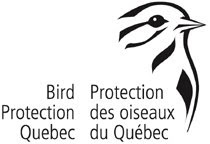 What a surprise yesterday morning in our nets, a Bicknell’s Thrush!! The difference with a Gray-cheeked Thrush is very small but by having the bird in the hand, it’s much easier! First, the wing is much shorter, 84mm in this case as opposed to more than 93 mm for a Gray-cheeked. We also noted the rufous tinge to the tail and more than half of the lower mandible was yellow, both good criteria to separate the 2 species.
What a surprise yesterday morning in our nets, a Bicknell’s Thrush!! The difference with a Gray-cheeked Thrush is very small but by having the bird in the hand, it’s much easier! First, the wing is much shorter, 84mm in this case as opposed to more than 93 mm for a Gray-cheeked. We also noted the rufous tinge to the tail and more than half of the lower mandible was yellow, both good criteria to separate the 2 species.It is only the third individual banded at MBO since 2004. It is also good to note that it was a hatch-year bird, born this summer, probably from the small population in Tremblant.
Last night was the start of our Saw-whet Owl migration monitoring. We caught 1 saw-whet, previously banded by our team last year at MBO. This bird is showing good migration route fidelity!!
McGill Bird Observatory - our Facebook page
Quelle surprise hier matin dans les filets, une Grive de Bicknell !! La différence avec la Grive à joues grises est assez subtile mais avec l’oiseau en main, c’est plus facile ! Tout d’abord, la mesure de l’aile est beaucoup plus petite, 84 mm dans ce cas-ci alors qu’une Grive à joues grises est de 93mm et plus. Nous avons aussi noté la queue d’une couleur légèrement roussâtre ainsi que plus de la moitié de la mandibule inférieure jaune, tous deux de bons critères pour distinguer les 2 espèces.
Il s’agit seulement du troisième individu bagué depuis 2004 à l’OOM. Il est bon de noter aussi qu’il s’agissait d’un individu né cet été, qui pourrait probablement provenir de la petite population du Mont Tremblant.
Hier soir, nous avons débuté le suivi de la migration de la Petite nyctale. Nous avons capturé 1 individu qui était déjà bagué. Il s’agit d’une nyctale baguée par notre équipe l’an dernier à l’OOM, excellente fidélité à la route de migration !! Simon Duval - Coordonnateur/Coordinator
Observatoire d'Oiseaux de McGill / - notre page Facebook
-------------------------------------------------------------------
2h30 minutes d'observation (6h00 à 8h30) en stationnaire au bout du quai: Plongeon huard ...8 (tous en vol, le plus souvent en solitaire, dans les 2 directions), Plongeon catmarin ...7 (mes premiers juvéniles observés. Un adulte à l'eau non-loin du quai, tous les autres au vol, dans les 2 directions) Grèbe esclavon ...2 (Mes premiers en 2011! Deux individus nagent et plongent non-loin en avant du quai!) Grèbe jougris ...9 (un groupe de 4, deux groupes de 2 et un solitaire, tous au vol vers l'est) Cormoran à aigrettes ...320 (plusieurs groupes au vol vers l'ouest. Quelques solitaires à l'eau et au vol vers l'est aussi) Grand Héron ...2 (dans la baie) Oie des neiges ...1600 (nombreux voiliers, tous vers l'ouest) Bernache du Canada ...250 (quelques voiliers, tous vers l'ouest) Canard noir ...44 (Quelques'uns à l'eau mais surtout de petits groupes au vol vers l'ouest) Canard colvert ...5 (au vol parmi des C. noirs) Canard pilet ...5 (au vol parmi des C. noirs) Fuligule milouinan ...7 (deux groupes au vol vers l'ouest) petit Fuligule ...4 (accompagnent des F. milouinans au vol) Eider à duvet ...65, (quelques petits groupes au vol vers l'est) Macreuse noire ...4 (un seul groupe, au vol vers l'est) Macreuse à front blanc ...7 (deux groupes au vol, un vers l'est, l'autre vers l'ouest) Harle huppé ...7 (un groupe de 2 puis de 5 au vol vers l'est) Pluvier semipalmé ...15 (quelques petits groupes au vol vers l'est) Chevalier grivelé ...1 (sur la plage) Bécasseau sanderling ...2 (au vol vers l'est avec d'autres limicoles) Bécasseau semipalmé ...120 (quelques petits groupes au vol vers l'est) Bécasseau variable ...10 (au vol avec d'autres limicoles) bécasseau sp. ...400 (au vol vers l'est et trop loin pour identification) Goéland à bec cerclé ...250 (nombreux à l'eau dans la ligne d'algues non-loin du quai) Goéland argenté ...15 (à travers les nombreux G. à bec cerclé) Goéland marin ...7 (idem) Mouette tridactyle ...2 (deux immatures ensemble au vol vers l'est, pas trop loin au large) Pipit d'Amérique ...4 (sur la plage) Jean-François Rousseau





No comments:
Post a Comment